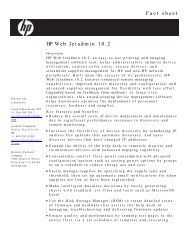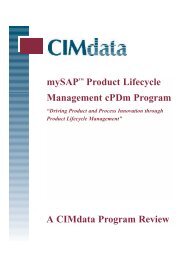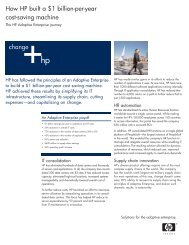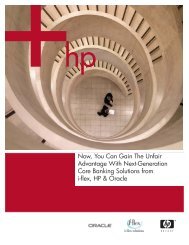Computing solutions for CD-adapco's STAR-CD and STAR-CCM+
Computing solutions for CD-adapco's STAR-CD and STAR-CCM+
Computing solutions for CD-adapco's STAR-CD and STAR-CCM+
Create successful ePaper yourself
Turn your PDF publications into a flip-book with our unique Google optimized e-Paper software.
<strong>Computing</strong> <strong>solutions</strong> <strong>for</strong> <strong>CD</strong>-adapco’s<br />
<strong>STAR</strong>-<strong>CD</strong> <strong>and</strong> <strong>STAR</strong>-<strong>CCM+</strong><br />
Technology <strong>for</strong> better business outcomes.<br />
Increase CAE productivity<br />
<strong>and</strong> focus on innovation<br />
with HP ProLiant servers <strong>and</strong><br />
<strong>CD</strong>-adapco <strong>solutions</strong><br />
Get increased computing power, reduced cost,<br />
enhanced quality, <strong>and</strong> greater speed in the<br />
manufacturing process when you combine <strong>CD</strong>-adapco<br />
<strong>solutions</strong> (<strong>STAR</strong>-<strong>CD</strong> <strong>and</strong> <strong>STAR</strong>-<strong>CCM+</strong>) <strong>and</strong> HP ProLiant<br />
servers. For simulated design projects—including<br />
fluid flow, heat transfer, <strong>and</strong> stress—this dynamic<br />
solution provides a high-per<strong>for</strong>mance computing<br />
(HPC) plat<strong>for</strong>m that is simple to deploy, operate, <strong>and</strong><br />
integrate with existing infrastructure <strong>and</strong> tools.<br />
Proven solver technology<br />
<strong>CD</strong>-adapco is a leading global provider of fullspectrum<br />
engineering simulation <strong>solutions</strong> <strong>for</strong> fluid<br />
flow, heat transfer, <strong>and</strong> stress. Computationally intense<br />
engineering <strong>solutions</strong> from <strong>CD</strong>-adapco, including<br />
<strong>STAR</strong>-<strong>CD</strong> <strong>and</strong> <strong>STAR</strong>-<strong>CCM+</strong>, are used across a wide<br />
range of industries including aerospace, automotive,<br />
biomedical, oil <strong>and</strong> gas, <strong>and</strong> heavy industry.<br />
Bridging the gap between fluid dynamics <strong>and</strong> structural<br />
mechanics, <strong>STAR</strong>-<strong>CD</strong> is a comprehensive solution<br />
<strong>for</strong> flow, thermal, <strong>and</strong> stress simulation. <strong>STAR</strong>-<strong>CCM+</strong><br />
is an engineering process-oriented Computational<br />
Fluid Dynamics (CFD) tool that delivers the latest CFD<br />
technology in a single integrated environment.<br />
Power <strong>for</strong> your projects<br />
HP ProLiant servers, BladeSystems, <strong>and</strong> Packaged<br />
Clusters offer excellent per<strong>for</strong>mance, increased<br />
uptime, <strong>and</strong> easier ownership. Choose servers with<br />
Intel ® Xeon ® or AMD Opteron processors to suit your<br />
computing needs.<br />
Cluster <strong>solutions</strong> <strong>for</strong> <strong>STAR</strong>-<strong>CD</strong> <strong>and</strong> <strong>STAR</strong>-<strong>CCM+</strong> are<br />
simple <strong>and</strong> fast with HP Cluster Plat<strong>for</strong>ms. These systems<br />
combine the flexibility of a custom solution with the<br />
simplicity, reliability, <strong>and</strong> value of a preconfigured,<br />
factory-built product. They are the foundation of the<br />
Unified Cluster Portfolio—a comprehensive, modular<br />
package of tested <strong>and</strong> pre-configured hardware,<br />
software, <strong>and</strong> services <strong>for</strong> scalable computation.
HP Cluster Plat<strong>for</strong>ms include:<br />
•<br />
•<br />
•<br />
•<br />
•<br />
•<br />
Broad choice of processors, cluster interconnects,<br />
<strong>and</strong> middleware<br />
Factory integration <strong>and</strong> testing, with final on-site<br />
installation<br />
Choice of packaging styles: dense or exp<strong>and</strong>able<br />
modular design with up to 1024 nodes<br />
Uni<strong>for</strong>m, worldwide specifications backed by an<br />
HP warranty <strong>and</strong> support<br />
Comprehensive software selection, tested <strong>and</strong><br />
verified by HP <strong>and</strong>/or its partners<br />
Rapid deployment services, including optional<br />
software installation, on-site training, <strong>and</strong><br />
implementation support<br />
For the best <strong>STAR</strong>-<strong>CD</strong> <strong>and</strong> <strong>STAR</strong>-<strong>CCM+</strong> price/<br />
per<strong>for</strong>mance combination on clusters, HP<br />
recommends the HP Cluster Plat<strong>for</strong>m 3000/3000BL<br />
<strong>and</strong> 4000/4000BL, which are based on the Quad-<br />
Core Intel Xeon processor <strong>and</strong> the AMD Opteron<br />
processor, respectively.<br />
Get more from multi-core<br />
HP-MPI is a high-per<strong>for</strong>mance, production-quality<br />
implementation of the Message-Passing Interface (MPI)<br />
st<strong>and</strong>ard <strong>for</strong> HP servers <strong>and</strong> workstations. When<br />
combined with <strong>CD</strong>-adapco <strong>STAR</strong>-<strong>CD</strong> <strong>and</strong> <strong>STAR</strong>-<br />
<strong>CCM+</strong>, HP-MPI:<br />
• Uses enhancements whenever appropriate to<br />
provide low latency <strong>and</strong> high b<strong>and</strong>width point-topoint<br />
<strong>and</strong> collective communication routines<br />
• Supports multi-protocol execution on server<br />
clusters to take advantage of shared memory <strong>for</strong><br />
intra-node communications<br />
• Supports multiple interconnects<br />
• Enables building a single executable that<br />
transparently takes advantage of the highper<strong>for</strong>mance<br />
interconnects<br />
1<br />
• Provides tools to allocate the number of cores<br />
per CPU <strong>for</strong> any given process, promoting<br />
faster time to solution <strong>and</strong> faster turnaround of<br />
application licenses<br />
1 A core is an individual CPU, <strong>and</strong> a processor is the physical chip<br />
containing one, two, or four cores.<br />
Figure 1<br />
HP Cluster Plat<strong>for</strong>m 3000BL<br />
• Nodes: HP ProLiant DL160<br />
G5, DL380 G5, BL2x220c,<br />
BL260c, BL460c, or BL480c<br />
servers<br />
• Cluster interconnects:<br />
InfiniB<strong>and</strong> or Gigabit<br />
Ethernet with Myrinet<br />
• OS: Linux ® or Microsoft<br />
Windows Server ® 2003<br />
• Cluster library <strong>and</strong> drivers:<br />
HP-MPI<br />
• Cluster managers: Linux:<br />
HP XC System Software, HP<br />
CMU, HP ICE-Linux, Plat<strong>for</strong>m<br />
Manager; Windows:<br />
Windows CCS<br />
Per<strong>for</strong>mance <strong>and</strong> architecture<br />
<strong>STAR</strong>-<strong>CCM+</strong> <strong>and</strong> <strong>STAR</strong>-<strong>CD</strong> per<strong>for</strong>mance depends on<br />
many factors in computer <strong>and</strong> cluster architecture.<br />
Memory b<strong>and</strong>width per core in the server or<br />
workstation is one of the most critical per<strong>for</strong>mance<br />
factors. Many HPC applications can compute faster<br />
than the memory can supply the needed data,<br />
resulting in less than perfect productivity. One way<br />
to improve this is to alter the number of cores utilized<br />
in each quad-core processor providing more memory<br />
b<strong>and</strong>width per core.<br />
HP engineers benchmark <strong>STAR</strong>-<strong>CCM+</strong> <strong>and</strong> <strong>STAR</strong>-<br />
<strong>CD</strong> to evaluate <strong>and</strong> improve its per<strong>for</strong>mance on HP<br />
servers <strong>and</strong> workstations giving you the data you need<br />
to select the best solution <strong>for</strong> the job.<br />
2
<strong>STAR</strong>-<strong>CD</strong> scaling benchmark<br />
Testing of the <strong>STAR</strong>-<strong>CD</strong> 3.26, 6-million cell A-Class<br />
st<strong>and</strong>ard benchmark on HP ProLiant clusters, one with<br />
Intel Xeon Processors <strong>and</strong> one with AMD Opteron<br />
Processors. Figure 2 shows that <strong>STAR</strong>-<strong>CD</strong> scales as the<br />
number of cores increases. As CPUs are added to the<br />
cluster, the simulation speed increases linearly on a<br />
correctly sized cluster.<br />
Systems used <strong>for</strong> benchmark:<br />
• HP ProLiant D165 G5 with AMD Opteron<br />
Processors 2536/ 2.3 GHz, quad-core<br />
•<br />
HP ProLiant DL160 G5 with Intel Xeon Processors<br />
E4572 / 3 GHz, 1600 MHz FSB, quad-core<br />
For this benchmark (<strong>and</strong> other scalable applications)<br />
the higher the level of parallelism, the higher the scaling<br />
of Intel Xeon Processor-based systems relative to AMD<br />
Opteron Processor-based systems. Likely, this is due<br />
to different architectural strengths in the processors<br />
themselves. AMD Opteron Processor’s strength is<br />
memory b<strong>and</strong>width. The Intel Xeon Processor’s strength<br />
is memory latency <strong>and</strong> cache size.<br />
For low levels of parallelism, memory b<strong>and</strong>width is the<br />
primary requirement <strong>for</strong> applications like <strong>STAR</strong>-<strong>CD</strong>. At<br />
higher levels of parallelism, the amount of data being<br />
computed by any one core becomes smaller <strong>and</strong><br />
smaller, <strong>and</strong> memory latency <strong>and</strong> cache size become<br />
more important. But per<strong>for</strong>mance will vary dependant<br />
on the input data set, the cluster network, <strong>and</strong> the level<br />
of parallelism.<br />
Figure 2:<br />
<strong>CD</strong>-adapco <strong>STAR</strong>-<strong>CD</strong> 4.06 Benchmark scaling on various HP clusters using a large<br />
dataset (Turbulent Flow around A-Class Car) with 5.9 million cells.<br />
Source: www.cd-adapco.com<br />
Scaling<br />
20<br />
18<br />
16<br />
14<br />
12<br />
10<br />
8<br />
6<br />
4<br />
2<br />
0<br />
HP Cluster Plat<strong>for</strong>m Scaling<br />
8 16 32<br />
# of Cores<br />
64 128<br />
DL165 G5<br />
(AMD Opteron<br />
quad-core)<br />
DL160 G5<br />
(Intel Xeon<br />
quad-core)<br />
Figure 3:<br />
<strong>STAR</strong>-<strong>CD</strong> 4.06 convergence benchmark per<strong>for</strong>mance using one, two or four of the<br />
available cores in an Intel Xeon quad-core processor. Per<strong>for</strong>mance per core improves<br />
when some of the cores are left idle. Source: www.cd-adapco.com<br />
Seconds elapsed<br />
60,000<br />
50,000<br />
40,000<br />
30,000<br />
20,000<br />
10,000<br />
0<br />
HP Cluster Plat<strong>for</strong>m Convergence using some or all of the<br />
available cores per quad-core processor<br />
8 cores<br />
16 cores<br />
32 cores<br />
4-Cores/Proc 2-Cores/Proc 1-Core/Proc<br />
<strong>STAR</strong>-<strong>CD</strong> convergence benchmark<br />
One of the most important characteristics influencing<br />
per<strong>for</strong>mance is memory b<strong>and</strong>width –specifically, the<br />
amount of memory b<strong>and</strong>width per core in the server<br />
or workstation. Many HPC applications can compute<br />
faster than the memory can supply the data, resulting<br />
in less-than-perfect productivity.<br />
You may want to maximize the application<br />
per<strong>for</strong>mance per core in order to achieve optimal<br />
software licensing. Consider running the job processes<br />
on some cores in the computer <strong>and</strong> leave other cores<br />
idle. The effectiveness of this approach depends on<br />
the application <strong>and</strong> the data set, <strong>and</strong> experimentation<br />
is required to measure the per<strong>for</strong>mance benefit. Good<br />
results of this approach are show in figure 3.<br />
To explain, consider a computer with two quad-core<br />
processors–8 cores in all. When a <strong>STAR</strong>-<strong>CCM+</strong> job<br />
is run, one or more job processes are started –one<br />
process per core. We have measured per<strong>for</strong>mance<br />
when one of four, two of four, or four of four cores are<br />
used to run job processes while the other cores are<br />
idle. The per<strong>for</strong>mance per core can vary dramatically.<br />
But the per<strong>for</strong>mance of the entire server is less than if<br />
all cores run job processes.<br />
If the goal is to maximize the application per<strong>for</strong>mance<br />
per computer, then it is always best to run job<br />
processes on all cores in the system.<br />
System used <strong>for</strong> benchmark: HP ProLiant BL460c with<br />
Intel Xeon Processors X5460 / 3.16 GHz, 1333 MHz<br />
FSB, quad--core<br />
3
Figure 4:<br />
<strong>STAR</strong>-<strong>CCM+</strong> benchmark using only half of the available cores improves iteration time.<br />
Average time per iteration<br />
30<br />
25<br />
20<br />
15<br />
10<br />
5<br />
<strong>STAR</strong>-<strong>CCM+</strong> using two or four cores in servers with two quad-core processors<br />
0 8 16 32 64 128 256<br />
Number of cores<br />
<strong>STAR</strong>-<strong>CCM+</strong> quad-core allocation<br />
benchmark<br />
To maximize application per<strong>for</strong>mance per core,<br />
you can run the job processes on some cores <strong>and</strong><br />
leave other cores idle. This effectively creates more<br />
memory b<strong>and</strong>width per core. The value of this<br />
approach depends on the application <strong>and</strong> the data<br />
set, <strong>and</strong> experimentation is required to measure the<br />
per<strong>for</strong>mance benefit. Still, <strong>for</strong> time-consuming runs, you<br />
may want to under-populate <strong>for</strong> faster time-to-solution<br />
<strong>and</strong> faster turnaround of application licenses. (Note<br />
that if you want to maximize application per<strong>for</strong>mance<br />
per computer, run your job processes on all cores in the<br />
system. This applies to both serial jobs parallel jobs.)<br />
Controlling how processes in your application job are<br />
positioned on the cores in each server requires unique<br />
capabilities in the tools running your applications.<br />
HP-MPI includes the ability to control the mapping<br />
of processes to cores. HP also contributed this<br />
functionality to SLURM, an open-source Linux tool.<br />
We tested <strong>STAR</strong>-<strong>CCM+</strong> per<strong>for</strong>mance by using two or<br />
four cores in servers with two quad-core processors.<br />
Technology <strong>for</strong> better business outcomes<br />
To learn more, visit www.hp.com/go/hpc<br />
We ran 20 iterations <strong>and</strong> determined the average<br />
time per iteration, shown in figure 4. Running <strong>STAR</strong>-<br />
<strong>CCM+</strong> using only 4 cores/server provides faster<br />
average time per iteration than 8 cores/server.<br />
System used <strong>for</strong> benchmark:<br />
• <strong>STAR</strong>-<strong>CCM+</strong> Version 2.10.017<br />
• Linux 64<br />
• 128 HP ProLiant BL460c nodes<br />
• 2 Intel Xeon Processors X5365/3 GHz, 8 MB L2,<br />
1333 MHz FSB, quad-core / node (2p/8c)<br />
• 16 GB PC2-5300 DDR2 Fully Buffered DIMMs node<br />
• InfiniB<strong>and</strong> ConnectX<br />
Boost your design process<br />
© Copyright 2008 Hewlett-Packard Development Company, L.P. The in<strong>for</strong>mation contained herein is subject to change without notice. The only warranties <strong>for</strong> HP products <strong>and</strong><br />
services are set <strong>for</strong>th in the express warranty statements accompanying such products <strong>and</strong> services. Nothing herein should be construed as constituting an additional warranty. HP<br />
shall not be liable <strong>for</strong> technical or editorial errors or omissions contained herein.<br />
Microsoft, Windows, <strong>and</strong> Windows Server are registered trademarks of Microsoft Corporation in the United States <strong>and</strong> other countries.<br />
Intel <strong>and</strong> Xeon are trademarks or registered of Intel Corporation or its subsidiaries in the United States <strong>and</strong> other countries.<br />
AMD, AMD Opteron, <strong>and</strong> combinations thereof, are trademarks of Advanced Micro Devices, Inc.<br />
Linux ® is the registered trademark of Linus Torvalds in the U.S. <strong>and</strong> other countries.<br />
4AA2-0197ENW, October 2008<br />
Using 8 cores/server<br />
Using 4 cores/server<br />
<strong>STAR</strong>-<strong>CD</strong>, <strong>STAR</strong>-<strong>CCM+</strong> <strong>and</strong> an HP ProLiant server<br />
cluster provides a powerful, scalable, parallel<br />
processing solution that is easy to deploy <strong>and</strong> use.<br />
With the processing speed necessary to run complex<br />
simulations, this dynamic combination translates into<br />
innovative, safer, <strong>and</strong> more af<strong>for</strong>dable products that<br />
are designed faster <strong>and</strong> at lower cost than be<strong>for</strong>e.

















